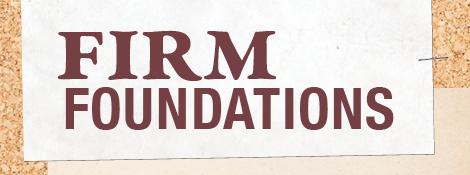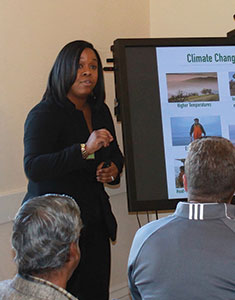Jack Suess
Jack Suess ’81, mathematics, and M.S. ’95, information systems, is the director of UMBC’s Division of Information Technology (DOIT) and a witness to UMBC’s amazing growth in this key area of 21st century academia.
What follows are edited excerpts from a recent UMBC Magazine interview with Suess.
Read our full story about how staff built UMBC’s information infrastructure.
On his professional path into computer science at UMBC
In those days, computer science was under mathematics. I was majoring in math, and in my sophomore year, I was doing the applied math track. And somebody said, ‘Well, if you do the applied math track, you ought to take these programming courses, because the computer might be helpful at some day.’
So I ended up starting to take some programming classes. And from that, it was just one of those things where I was taking a couple programming classes, continuing to do the math, and I got an opportunity to be a teaching assistant for the COBOL class they wanted for economics. I really enjoyed sort of explaining to people how to solve their problems. So I got offered a job working in UMBC’s computer center it was called at that time. It was up on the third floor of what is now the Sondheim Building.
Up until then, I had been working either in retail at a small place or as a dishwasher. But it was always hard to take my programming classes because I didn’t have remote access. So you had to be here at UMBC to get access to the computer. So when the summer job came around, it really opened up the opportunity to continue taking the programming classes because now I could get access through my job….
I think I officially graduated in December. But I ended up just staying and taking classes in the spring because there were some classes I wanted to take, and they said I could continue working as a student. At the end of the spring, they had a position that came available here and they asked me if I wanted to apply for it. I did. And I was lucky enough to get it. And I started working at UMBC in June 1981 as a programmer analyst. I was actually doing administrative programming work where I designed databases and other sorts of applications for people.
On being there at the dawn of UMBC computing infrastructure
Up until 1982, all of our computing came from College Park from the academic side. There was a big mainframe at College Park and we were connected to that mainframe. And in 1982, the campus decided that it was going to go out and buy a big mainframe computer from a company called Control Data Corporation. CDC. It was a huge machine. It was housed in the basement of the library. It took up all of 2000 square feet of space for this beast of a machine.
In bringing that machine in, they needed somebody who could do what was called systems programming. Operate the machine and do upgrades to the operating system. And since I was the most recent graduate in the administrative side that actually had done the computer science – they asked me if I would do it. I ended up getting transferred over after about a year to be working on the CDC cyber system.
What’s always been amazing about UMBC is we were trying – and usually succeeding – at doing things we should never have thought we could do. The CDC machines usually had staffs of dozens of trained people to operate then. But it was myself – and then we had two or three really incredible students – who were running this sort of thing.
The CDC only lasted here a few years. Originally the funding model was that we were going to bring in this huge machine that would provide the academic computing context for UMBC, and it would also be used for instructional computing in Baltimore city schools. There was an application that Control Data had come out with called PLAY-DOH, which was the first sort of computer aided instruction.
It turned out we bought this and started heading down this path just as the first IBM PC was released. Then a year or two, it became apparent that the PC was the way to go, not using these dedicated specialized terminals that were going to be there for the PLAY-DOH system. And so they ended up deciding that they were going to get rid of the PLAY-DOH system.
One of the good things that came out of it was I got to teach for the first time. I think it was in 1983. There was a class in assembly language programming that was required in computer science, and they couldn’t find an instructor who knew the CDC assembly line language. Since I had learned it as part of my work, I got pulled into teaching the class. And that was probably a thing that really helped me. Having to get up and actually teach a class was something that gave me a lot of appreciation for how hard it is to teach and gave me more confidence to be able to go in and do these sorts of things.
Hooking up UMBC to the Internet and beyond
The turning point at UMBC was 1985. We decided to get rid of CDC and we ended up buying a large system from Digital Equipment Corporation. In buying that equipment, we ended up buying our first UNIX system that would be there, along with software that allowed you to hook that software system up to something called Bitmap. And Bitmap was really sort of the first communication system that went campus to campus. It allowed you to send email across campuses or you could transfer files from one campus to another. It was the first touch of what you think of as the Internet or networking.
In 1986, we ended up actually getting on the Internet when we got our first Internet connection on campus. That’s the time frame around the idea of Internet taking hold at UMBC. It was fun because you were starting to sort of explore the connectedness that was out there. I don’t think that at that point in time people were truly thinking how much [the Internet] was going to reshape the world. I certainly didn’t fully grasp it at that point of time.
The other thing that we ended up doing in 1985 was we set up the first Ethernet network on campus. And we started to hook other computers into that, so that you are starting to get the ability from your computer to connect in and do something. It was still minimalistic in 1985 but it was really the starting point.
The next big transition was in 1992 around the opening of the Engineering Building. What was transformative about that building was that we were able to get most of the equipment that we had requested.… We had a partnership with Silicon Graphics – now known as SGI – and we had decided to buy about 250 Silica and Graphics workstations. Most of our labs were running the Silica and Graphics workstations. We bought these big, high performance computing systems. So that’s where we started supporting that. All of our faculty in computer science ended up getting SGI workstations.
What was opportunistic about having that UNIX infrastructure is in the early 1990s was that the web is initially designed for UNIX. It didn’t work on an IBM PC. A little bit later they ended up having a sort of a Mac browser. But to really get the full browser experience, you needed a UNIX workstation. So the campus adopted the web, adopted UNIX, and leveraged the Internet in a completely different way than we would have because of the fact that we had all of these UNIX workstations that had come with the building. We could build up a much more robust environment.
Tags: Winter 2016



